View in other NatureServe Network Field Guides
NatureServe
Montana
Utah
Wyoming
Idaho
Wisconsin
British Columbia
South Carolina
Yukon
California
New York
Clark's Nutcracker - Nucifraga columbiana
State Rank Reason (see State Rank above)
Species is common to uncommon within montane conifer forests, primarily in subalpine ecosystems. It appears to be undergoing minor declines but is facing significant threats due to loss of food resources due to declines in Whitebark Pines and from fire and fire suppression. Moderate increases in average temperature are predicted to result in moderate habitat loss for the species.
General Description
Clark's Nutcracker is a jay-sized corvid that is crowlike in build and flight, with moderate sexual size dimorphism. Total length of adults 27.0 to 30.1 cm. Mass 106 to 161 g. Males slightly larger than females. Sexes similar in appearance. Light to medium gray, with varying amounts of white around eyes, on forehead, and on chin; white around vent and at base of tail; wings and tail glossy black; secondaries broadly tipped with white forming a white patch; outer rectrices white. Folded wings nearly reach tip of tail. Long, pointed, black bill with short nasal bristles. Distinctive grating call audible at great distance (Tomback 1998).
For a comprehensive review of the conservation status, habitat use, and ecology of this and other Montana bird species, please see
Marks et al. 2016, Birds of Montana.Diagnostic Characteristics
Clark's Nutcracker is distinctive in appearance and behavior, and unlike any other corvid in Montana. Plumage is similar to that of the Northern Shrike and Northern Mockingbird, but the longer, straighter bill and larger body distinguish nutcrackers from these species. White and black markings in the wings and tail, in combination with the other body characters and the sharp grating "craaaww" call, help distinguish a nutcracker. Other similar-appearing species don't travel in conspecific flocks, as nutcrackers often do.
Species Range
Montana Range
Range Descriptions
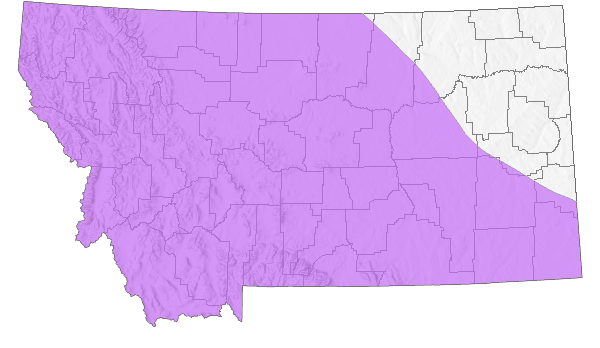
 Year-round
Year-round
Western Hemisphere Range
 eBird Occurrence Map
eBird Occurrence Map
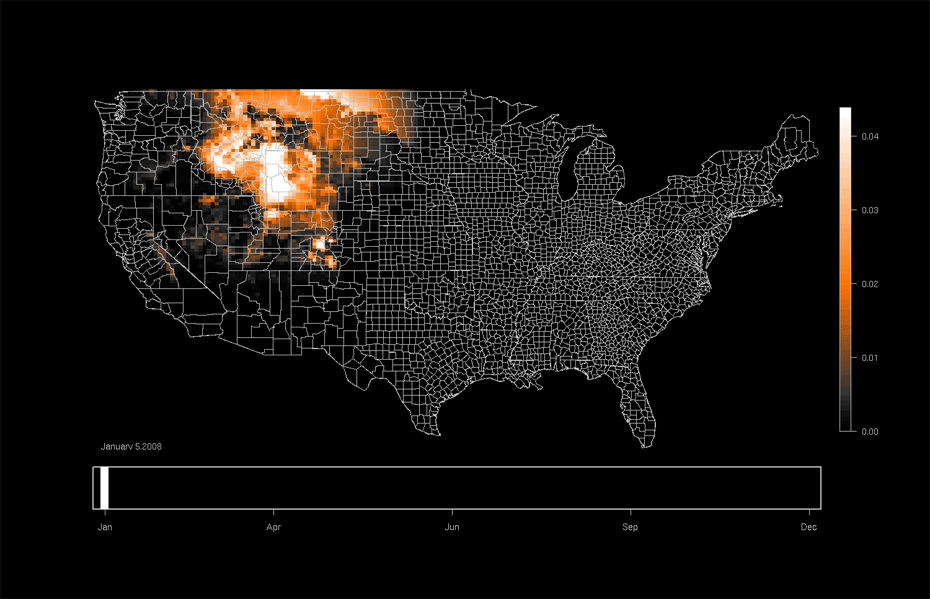
Click the map for more info.
Courtesy of

and

Range Comments
Clark's Nutcrackers are year-round residents from central British Columbia and west-central Alberta south through the mountain ranges and pine-covered ridges of the West to southern California, Arizona, and New Mexico; an isolated population persists on Cerro el Potosi in Nuevo Leon, Mexico (Contreras-Balderas 1992, Tomback 1998).
Observations in Montana Natural Heritage Program Database
Number of Observations: 22702
(Click on the following maps and charts to see full sized version)
Map Help and Descriptions
Relative Density
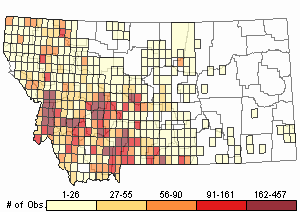
Recency
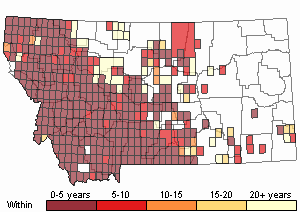
SUMMER (Feb 16 - Dec 14)
Direct Evidence of Breeding

Indirect Evidence of Breeding

No Evidence of Breeding

WINTER (Dec 15 - Feb 15)
Regularly Observed

Not Regularly Observed


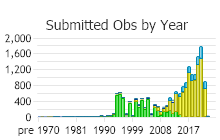
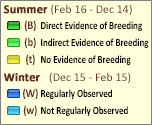 (Observations spanning multiple months or years are excluded from time charts)
(Observations spanning multiple months or years are excluded from time charts)
Migration
Permanent resident in the state. May be nomadic but not migratory in the typical sense.
Habitat
Nutcrackers in Montana typically occupy conifer forests dominated by whitebark pine at higher elevations and ponderosa pine and limber pine along with Douglas firs at lower elevations, relying largely on seeds of these species for food (Saunders 1921, Mewaldt 1956, Giuntoli and Mewaldt 1978). They often are seen above treeline in alpine meadows or flying among drainages (Johnson 1966, Pattie and Verbeek 1966).
National Vegetation Classification System Groups Associated with this Species
Forest and Woodland
Low Elevation - Xeric Forest and Woodland
Montane - Subalpine Forest and Woodland
Shrubland
Foothills - Montane Shrubland
Grassland
Montane - Subalpine Grassland
Wetland and Riparian
Alpine Riparian and Wetland
Peatland
Riparian and Wetland Forest
Riparian Shrubland
Wet Meadow and Marsh
Recently Disturbed or Modified
Insect-Killed Forest
Food Habits
The year-round diet consists primarily of fresh and stored pine seeds, but also includes insects and spiders, small animals (birds and mammals) and carrion (Tomback 1998). Conifer seeds (mostly ponderosa pine) made up 83% of the ingested food and occurred in the stomachs of all but nine of the 426 nutcrackers collected at low to moderate elevation in western Montana during 1946-1949. Nutcrackers ate Douglas fir seeds only during the fall and winter of 1946-47, when a bumper crop occurred (Giuntoli and Mewaldt 1978).
Ecology
Family groups and non-breeding Clark's Nutcrackers occupy large home ranges in spring and summer, which are based on location of seed caches (Tomback 1998). Pine seeds can be transported up to 32.6 km (19.5 miles) for caching in home ranges (Lorenz et al. 2011). Nutcrackers have a mutualistic relationship with whitebark pine, being the primary agent of dispersal for the pines, which in turn are a major source of food for the nutcrackers throughout the year (Lanner 1996, Tomback 1998). Caches contain typically 1-15 seeds; a single nutcracker may cache as many as 35,000-98,000 pine seeds in late summer and fall. A flock of about 20 nutcrackers at 2,610 m (8565 ft) in the Pioneer Mountains in early September stored an average of 3.6 whitebark pine seeds per cache (n = 95 caches, range = 1-9 seeds) and covered each cache with earth or vegetation, effectively depositing the seeds at bill depth (Paul Hendricks, personal observation). Memory of caches is retained as long as 285 days; retrieval of caches sustains birds when cones are not available on trees. Breeding territories are much smaller than home ranges. One Montana breeding territory was 0.85 ha (2.1 acres) in size (Mewaldt 1956). Raptors are the major predators of adults and juveniles. BBS data indicate a non-significant decline in numbers of 2.2% per year in Montana from 1980-2007 and a significant increase of 1.2% per year survey-wide during the same period. Numbers of birds seen per party hour on Montana CBCs have fluctuated widely but suggest no long-term trend.
Reproductive Characteristics
Nest building has been observed in Montana from 26 February to 19 April, egg laying from 18 March to 21 April, and brood rearing from 30 March to 9 May; fledglings have been seen as early as 12 April (Pyfer 1897, Silloway 1903, Saunders 1921, Mewaldt 1956, Weydemeyer 1975). Clutch sizes reported in Montana have ranged from two to five (usually three) eggs. Nests occur in Douglas-fir or ponderosa pine, 1.8 to 24.4 m (6 to 80 ft) above ground.
Management
No management activities specific to Clark's Nutcracker are currently occuring in Montana. Clark's Nutcracker is dependent on conifer seeds, particularly pine seeds. Loss of pines (whitebark, limber, ponderosa) to fire, disease, and bark beetle outbreaks could impact populations; management activities promoting the health of pines will benefit nutcrackers.
Stewardship Responsibility
Threats or Limiting Factors
Loss of whitebark, limber, and ponderosa pines to disease, insect outbreaks, and fire may lead to local and widespread population declines (Tomback 1998).
References
- Literature Cited AboveLegend:
 View Online Publication
View Online Publication Contreras-Balderas, A.J. 1992. Status of Clark's nutcrackers on Cerro El Potosi, Nuevo Leon, Mexico. Western Birds 23: 181-182.
Contreras-Balderas, A.J. 1992. Status of Clark's nutcrackers on Cerro El Potosi, Nuevo Leon, Mexico. Western Birds 23: 181-182. Giuntoli, M. and L. R. Mewaldt. 1978. Stomach contents of Clark's nutcrackers collected in western Montana. Auk 95:595-598
Giuntoli, M. and L. R. Mewaldt. 1978. Stomach contents of Clark's nutcrackers collected in western Montana. Auk 95:595-598 Johnson, R. E. 1966. Alpine birds of the Little Belt Mountains, Montana. Wilson Bulletin 78:225-227.
Johnson, R. E. 1966. Alpine birds of the Little Belt Mountains, Montana. Wilson Bulletin 78:225-227. Lanner, R.M. 1996. Made for each other: a symbiosis of birds and pines. Oxford University Press, New York, NY. 160 pp.
Lanner, R.M. 1996. Made for each other: a symbiosis of birds and pines. Oxford University Press, New York, NY. 160 pp. Lorenz, T.J., K.A. Sullivan, A.V. Bakian, and C.A. Aubry. 2011. Cache-site selection in Clark's nutcracker (Nucifraga columbiana). The Auk 128(2): 237-247.
Lorenz, T.J., K.A. Sullivan, A.V. Bakian, and C.A. Aubry. 2011. Cache-site selection in Clark's nutcracker (Nucifraga columbiana). The Auk 128(2): 237-247. Marks, J.S., P. Hendricks, and D. Casey. 2016. Birds of Montana. Arrington, VA. Buteo Books. 659 pages.
Marks, J.S., P. Hendricks, and D. Casey. 2016. Birds of Montana. Arrington, VA. Buteo Books. 659 pages. Mewaldt, L.R. 1956. Nesting behavior of the Clark's nutcracker. Condor 58:3-23.
Mewaldt, L.R. 1956. Nesting behavior of the Clark's nutcracker. Condor 58:3-23. Pattie, D.L. and N.A.M. Verbeek. 1966. Alpine birds of the Beartooth Mountains. The Condor 68(2):167-176.
Pattie, D.L. and N.A.M. Verbeek. 1966. Alpine birds of the Beartooth Mountains. The Condor 68(2):167-176. Pyfer, A.M. 1897. The nesting of Clark's nutcracker. Oologist 14:100-101
Pyfer, A.M. 1897. The nesting of Clark's nutcracker. Oologist 14:100-101 Saunders, A.A. 1921. A distributional list of the birds of Montana: With notes on the migration and nesting of the better known species. Pacific Coast Avifauna No. 14. pp. 38-39, 118-119.
Saunders, A.A. 1921. A distributional list of the birds of Montana: With notes on the migration and nesting of the better known species. Pacific Coast Avifauna No. 14. pp. 38-39, 118-119. Silloway, P. M. 1903. Additional notes to summer birds of Flathead Lake, with special reference to Swan Lake. Bulletin of the University of Montana No. 18, Biological Series No. 6. 293-308 p.
Silloway, P. M. 1903. Additional notes to summer birds of Flathead Lake, with special reference to Swan Lake. Bulletin of the University of Montana No. 18, Biological Series No. 6. 293-308 p. Tomback, D.F. 1998. Clark's nutcracker (Nucifraga columbiana). Species Account Number 331. The Birds of North America Online (A. Poole, Ed.). Cornell Laboratory of Ornithology, Ithaca, NY. Retrieved 3/25/2008 from The Birds of North America Online database.
Tomback, D.F. 1998. Clark's nutcracker (Nucifraga columbiana). Species Account Number 331. The Birds of North America Online (A. Poole, Ed.). Cornell Laboratory of Ornithology, Ithaca, NY. Retrieved 3/25/2008 from The Birds of North America Online database. Weydemeyer, W. 1975. Half-century record of the breeding birds of the Fortine area, Montana: Nesting data and population status. Condor 77:281-287.
Weydemeyer, W. 1975. Half-century record of the breeding birds of the Fortine area, Montana: Nesting data and population status. Condor 77:281-287.
- Additional ReferencesLegend:
 View Online Publication
View Online Publication
Do you know of a citation we're missing? American Ornithologists’ Union [AOU]. 1998. Check-list of North American birds, 7th edition. American Ornithologists’ Union, Washington, D.C. 829 p.
American Ornithologists’ Union [AOU]. 1998. Check-list of North American birds, 7th edition. American Ornithologists’ Union, Washington, D.C. 829 p. Beak Consultants, Inc. 1983. Wildlife. January 1983. In Stillwater Project Environmental Studies. Addendum A, Wildlife. Vol. I. Tech. Report No. 7. 1982.
Beak Consultants, Inc. 1983. Wildlife. January 1983. In Stillwater Project Environmental Studies. Addendum A, Wildlife. Vol. I. Tech. Report No. 7. 1982. Butts, T.W., Western Technology and R.L. Eng. 1993. Continental Lime Indian Creek Mine, Townsend, MT. Life of Mine Wildlife Reconnaissance. In Life-of-Mine Amendment. Continental Lime, Inc., Indian Creek Mine & Plant. Vol. 2. October 13, 1992.
Butts, T.W., Western Technology and R.L. Eng. 1993. Continental Lime Indian Creek Mine, Townsend, MT. Life of Mine Wildlife Reconnaissance. In Life-of-Mine Amendment. Continental Lime, Inc., Indian Creek Mine & Plant. Vol. 2. October 13, 1992. Casey, D. 2000. Partners in Flight Draft Bird Conservation Plan Montana. Version 1.0. 287 pp.
Casey, D. 2000. Partners in Flight Draft Bird Conservation Plan Montana. Version 1.0. 287 pp. Casey, D. 2005. Rocky Mountain Front avian inventory. Final report. Prepared for the U.S. Fish and Wildlife Service and The Nature Conservancy by the American Bird Conservancy, Kalispell, Montana.
Casey, D. 2005. Rocky Mountain Front avian inventory. Final report. Prepared for the U.S. Fish and Wildlife Service and The Nature Conservancy by the American Bird Conservancy, Kalispell, Montana. Confluence Consulting Inc. 2010. Montana Department of Transportation Wetland Mitigation Monitoring Reports (various sites). MDT Helena, MT.
Confluence Consulting Inc. 2010. Montana Department of Transportation Wetland Mitigation Monitoring Reports (various sites). MDT Helena, MT. Confluence Consulting Inc. 2011. Montana Department of Transportation Wetland Mitigation Monitoring Reports (various sites). MDT Helena, MT.
Confluence Consulting Inc. 2011. Montana Department of Transportation Wetland Mitigation Monitoring Reports (various sites). MDT Helena, MT. Dickson, D.C. 1991. Systematic wildlife observations on the Blackfoot-Clearwater Wildlife Management Area. Montana Department of Fish, Wildlife and Parks. Missoula, MT. 14 pp. plus appendices and photographs.
Dickson, D.C. 1991. Systematic wildlife observations on the Blackfoot-Clearwater Wildlife Management Area. Montana Department of Fish, Wildlife and Parks. Missoula, MT. 14 pp. plus appendices and photographs. DuBois, K.L. 1979. An inventory of the avifauna in the Long Pines of Southeastern Montana. M.Sc. Thesis. Bozeman, MT: Montana State University. 113 p.
DuBois, K.L. 1979. An inventory of the avifauna in the Long Pines of Southeastern Montana. M.Sc. Thesis. Bozeman, MT: Montana State University. 113 p. ECON, Inc. (Ecological Consulting Service), Helena, MT., 1979, Annual wildllife report of the Colstrip Area for 1978. Proj. 195-85-A. April 6, 1979.
ECON, Inc. (Ecological Consulting Service), Helena, MT., 1979, Annual wildllife report of the Colstrip Area for 1978. Proj. 195-85-A. April 6, 1979. Econ, Inc. 1988. Wildlife monitoring report, 1987 field season, Big Sky Mine. March 1988. In Peabody Mining and Reclamation Plan Big Sky Mine Area B. Vol. 8, cont., Tab 10 - Wildlife Resources. Appendix 10-1, 1987 Annual Wildlife Report.
Econ, Inc. 1988. Wildlife monitoring report, 1987 field season, Big Sky Mine. March 1988. In Peabody Mining and Reclamation Plan Big Sky Mine Area B. Vol. 8, cont., Tab 10 - Wildlife Resources. Appendix 10-1, 1987 Annual Wildlife Report. Econ, Inc., Helena, MT., 1991, Wildlife monitoring report: 1989 field season, Big Sky Mine. March 1991.
Econ, Inc., Helena, MT., 1991, Wildlife monitoring report: 1989 field season, Big Sky Mine. March 1991. Ehrlich, P., D. Dobkin, and D. Wheye. 1988. The birder’s handbook: a field guide to the natural history of North American birds. Simon and Schuster Inc. New York. 785 pp.
Ehrlich, P., D. Dobkin, and D. Wheye. 1988. The birder’s handbook: a field guide to the natural history of North American birds. Simon and Schuster Inc. New York. 785 pp. Elliott, Joe C. and Hydrometrics, Inc., Helena, MT., 1994, Supplement to wildlife baseline investigation life-of-mine expansion plan: Regal Mine, Barretts Minerals, Inc., Madison County, Montana. August 2000. In Life-of Mine Expansion Plan: Barretts Minerals, Inc., Regal Mine, Madison County, Montana. Vol. 2. App. C: Baseline Wildlife Reconnaissance. December 1999.
Elliott, Joe C. and Hydrometrics, Inc., Helena, MT., 1994, Supplement to wildlife baseline investigation life-of-mine expansion plan: Regal Mine, Barretts Minerals, Inc., Madison County, Montana. August 2000. In Life-of Mine Expansion Plan: Barretts Minerals, Inc., Regal Mine, Madison County, Montana. Vol. 2. App. C: Baseline Wildlife Reconnaissance. December 1999. Eng, R.L. 1976. Wildlife Baseline Study [for West Fork of the Stillwater and Picket Pin drainages]
Eng, R.L. 1976. Wildlife Baseline Study [for West Fork of the Stillwater and Picket Pin drainages] Farmer, Pat, and Dean Culwell, Westech, Inc. [Western Technology and Engineering], Helena, MT., 1981, Terrestrial wildlife reconnaissance. March 1981.
Farmer, Pat, and Dean Culwell, Westech, Inc. [Western Technology and Engineering], Helena, MT., 1981, Terrestrial wildlife reconnaissance. March 1981. Farmer, Patrick J., and Thomas W. Butts, Western Technology & Eng., Inc., Helena, MT., 1994, McDonald Project Terrestrial Wildlife Study, November 1989 - November 1993. April 1994. In McDonald Gold Project: Wildlife & Fisheries. [#18]. Seven-up Pete Joint Venture, Lincoln, MT. Unpub. No date.
Farmer, Patrick J., and Thomas W. Butts, Western Technology & Eng., Inc., Helena, MT., 1994, McDonald Project Terrestrial Wildlife Study, November 1989 - November 1993. April 1994. In McDonald Gold Project: Wildlife & Fisheries. [#18]. Seven-up Pete Joint Venture, Lincoln, MT. Unpub. No date. Farmer, Patrick. J., et al., Western Technology and Eng., Inc., Helena, MT., 1984, Montana Tunnels Project Baseline Terrestrial Wildlife Study. December 14, 1984. In Application for a Hard Rock Operating Permit, Montana Tunnels Project, Jefferson County, Montana. Vol. 3. Environmental Baseline Reports. (Centennial Minerals, Inc., Hydrometrics, 1984?)
Farmer, Patrick. J., et al., Western Technology and Eng., Inc., Helena, MT., 1984, Montana Tunnels Project Baseline Terrestrial Wildlife Study. December 14, 1984. In Application for a Hard Rock Operating Permit, Montana Tunnels Project, Jefferson County, Montana. Vol. 3. Environmental Baseline Reports. (Centennial Minerals, Inc., Hydrometrics, 1984?) Fjell, Alan K., and Brian R. Mahan., 1985, Peabody Coal Company Big Sky Mine, Rosebud County, MT. Wildlife monitoring report: 1984 field season. February 1985.
Fjell, Alan K., and Brian R. Mahan., 1985, Peabody Coal Company Big Sky Mine, Rosebud County, MT. Wildlife monitoring report: 1984 field season. February 1985. Goodell, J. 2012. Morse Land Company Breeding Bird Inventory And Analysis. High Desert Museum. Bend, OR. 42 pp + Appendices.
Goodell, J. 2012. Morse Land Company Breeding Bird Inventory And Analysis. High Desert Museum. Bend, OR. 42 pp + Appendices. Hays, R., R.L. Eng, and C.V. Davis (preparers). 1984. A list of Montana birds. Helena, MT: MT Dept. of Fish, Wildlife & Parks.
Hays, R., R.L. Eng, and C.V. Davis (preparers). 1984. A list of Montana birds. Helena, MT: MT Dept. of Fish, Wildlife & Parks. Hejl, S.J., R.L. Hutto, C.R. Preston, and D.M. Finch. 1995. The effects of silvicultural treatments on forest birds in the Rocky Mountains. pp. 220-244 In: T.E. Martin and D.M. Finch (eds). Ecology and Management of Neotropical Migratory Birds. New York, NY: Oxford Univ. Press. 489 p.
Hejl, S.J., R.L. Hutto, C.R. Preston, and D.M. Finch. 1995. The effects of silvicultural treatments on forest birds in the Rocky Mountains. pp. 220-244 In: T.E. Martin and D.M. Finch (eds). Ecology and Management of Neotropical Migratory Birds. New York, NY: Oxford Univ. Press. 489 p. Henderson, S. 1997. Effects of fire on avian distributions and patterns of abundance over two vegetation types in southwest Montana : implications for managing fire for biodiversity. M.Sc. Thesis. Bozeman, MT: Montana State University. 95 p.
Henderson, S. 1997. Effects of fire on avian distributions and patterns of abundance over two vegetation types in southwest Montana : implications for managing fire for biodiversity. M.Sc. Thesis. Bozeman, MT: Montana State University. 95 p. Hendricks, P. 2000. Roadside bird counts on BLM lands in Petroleum and Fergus Counties, Montana. Montana Natural Heritage Program, Helena, MT. 57pp.
Hendricks, P. 2000. Roadside bird counts on BLM lands in Petroleum and Fergus Counties, Montana. Montana Natural Heritage Program, Helena, MT. 57pp. Hoffland, John Robert. 1995. A comparison of bird abundance among selectively logged old-growth and mature second-growth Ponderosa Pine. M.S. Thesis. University of Montana. Missoula, MT.
Hoffland, John Robert. 1995. A comparison of bird abundance among selectively logged old-growth and mature second-growth Ponderosa Pine. M.S. Thesis. University of Montana. Missoula, MT. Hoffmann, R.S. 1960. Summer birds of the Little Belt Mountains, Montana. Missoula, MT: Occasional Papers of Montana State University No. 1. 18 p.
Hoffmann, R.S. 1960. Summer birds of the Little Belt Mountains, Montana. Missoula, MT: Occasional Papers of Montana State University No. 1. 18 p. Humphris, Michael., 1990, Wildlife Monitoring Report. Spring Creek Coal Company 1990 Mining Annual Report. Appendix I. April 11, 1990.
Humphris, Michael., 1990, Wildlife Monitoring Report. Spring Creek Coal Company 1990 Mining Annual Report. Appendix I. April 11, 1990. Hutto, R. L., and J. S. Young. 1999. Habitat relationships of landbirds in the Northern Region, USDA Forest Service. U.S. Forest Service General Technical Report RMRS-GTR-32, Ogden, Utah.
Hutto, R. L., and J. S. Young. 1999. Habitat relationships of landbirds in the Northern Region, USDA Forest Service. U.S. Forest Service General Technical Report RMRS-GTR-32, Ogden, Utah. Johnsgard, P.A. 1992. Birds of the Rocky Mountains with particular reference to national parks in the northern Rocky Mountain region. Lincoln: University of Nebraska Press. xi + 504 pp.
Johnsgard, P.A. 1992. Birds of the Rocky Mountains with particular reference to national parks in the northern Rocky Mountain region. Lincoln: University of Nebraska Press. xi + 504 pp. Joslin, Gayle, and Heidi B. Youmans. 1999. Effects of recreation on Rocky Mountain wildlife: a review for Montana. [Montana]: Montana Chapter of the Wildlife Society.
Joslin, Gayle, and Heidi B. Youmans. 1999. Effects of recreation on Rocky Mountain wildlife: a review for Montana. [Montana]: Montana Chapter of the Wildlife Society. Kovalenko, Vladimir. 2023. The birds and the trees: Quantifying the drivers of Whitebark Pine decline and Clark's Nutcracker habitat use in Glacier National Park. M.S. Thesis. University of Montana. Missoula, MT.
Kovalenko, Vladimir. 2023. The birds and the trees: Quantifying the drivers of Whitebark Pine decline and Clark's Nutcracker habitat use in Glacier National Park. M.S. Thesis. University of Montana. Missoula, MT. Lenard, S., J. Carlson, J. Ellis, C. Jones, and C. Tilly. 2003. P. D. Skaar's Montana bird distribution, 6th edition. Montana Audubon, Helena, MT. 144 pp.
Lenard, S., J. Carlson, J. Ellis, C. Jones, and C. Tilly. 2003. P. D. Skaar's Montana bird distribution, 6th edition. Montana Audubon, Helena, MT. 144 pp. Madge, S. and H. Burn. 1994. Crows and Jays: A guide to crows, jays, and magpies of the world. Houghton Mifflin Company, N.Y. 191 pp.
Madge, S. and H. Burn. 1994. Crows and Jays: A guide to crows, jays, and magpies of the world. Houghton Mifflin Company, N.Y. 191 pp. Maxell, B.A. 2016. Northern Goshawk surveys on the Beartooth, Ashland, and Sioux Districts of the Custer-Gallatin National Forest: 2012-2014. Montana Natural Heritage Program. Helena, MT. 114pp.
Maxell, B.A. 2016. Northern Goshawk surveys on the Beartooth, Ashland, and Sioux Districts of the Custer-Gallatin National Forest: 2012-2014. Montana Natural Heritage Program. Helena, MT. 114pp. McCaughey, W.W. 1990. Biotic and microsite factors affecting Pinus albicaulis establishment and survival. Ph.D. Dissertation. Bozeman, MT: Montana State University. 78 p.
McCaughey, W.W. 1990. Biotic and microsite factors affecting Pinus albicaulis establishment and survival. Ph.D. Dissertation. Bozeman, MT: Montana State University. 78 p. Mewaldt, L. R. 1948. Nesting Habits and Some General Notes On Clark'S Nutcracker (Nucifraga Columbiana Wilson). M.A. Thesis. University of Montana, Missoula. 117 Pp.
Mewaldt, L. R. 1948. Nesting Habits and Some General Notes On Clark'S Nutcracker (Nucifraga Columbiana Wilson). M.A. Thesis. University of Montana, Missoula. 117 Pp. Montana Bird Distribution Committee. 2012. P.D. Skaar's Montana bird distribution. 7th Edition. Montana Audubon, Helena, Montana. 208 pp. + foldout map.
Montana Bird Distribution Committee. 2012. P.D. Skaar's Montana bird distribution. 7th Edition. Montana Audubon, Helena, Montana. 208 pp. + foldout map. Mosher, B.A. 2011. Avian community response to a mountain beetle epidemic. M.Sc. Thesis. Bozeman, MT: Montana State University. 55 p.
Mosher, B.A. 2011. Avian community response to a mountain beetle epidemic. M.Sc. Thesis. Bozeman, MT: Montana State University. 55 p. MT Fish, Wildlife & Parks. No date. Blackfoot-Clearwater Wildlife Management Area checklist.
MT Fish, Wildlife & Parks. No date. Blackfoot-Clearwater Wildlife Management Area checklist. Newlon, K.R. 2005. Demography of Lewis's Woodpecker, breeding bird densities, and riparian Aspen integrity in a grazed landscape. M.Sc. Thesis. Bozeman, MT: Montana State University. 101 p.
Newlon, K.R. 2005. Demography of Lewis's Woodpecker, breeding bird densities, and riparian Aspen integrity in a grazed landscape. M.Sc. Thesis. Bozeman, MT: Montana State University. 101 p. OEA Research, Helena, MT., 1982, Beal Mine Wildlife Report. June 17, 1982.
OEA Research, Helena, MT., 1982, Beal Mine Wildlife Report. June 17, 1982. Oechsli, L.M. 2000. Ex-urban development in the Rocky Mountain West: consequences for native vegetation, wildlife diversity, and land-use planning in Big Sky, Montana. M.Sc. Thesis. Montana State University, Bozeman. 73 p.
Oechsli, L.M. 2000. Ex-urban development in the Rocky Mountain West: consequences for native vegetation, wildlife diversity, and land-use planning in Big Sky, Montana. M.Sc. Thesis. Montana State University, Bozeman. 73 p. Pilliod, D.S. 2002. Clark's Nutcracker (Nucifraga columbiana) predation on tadpoles of the Columbia Spotted frog (Rana luteiventris). Northwestern Naturalist 83(2):59-61.
Pilliod, D.S. 2002. Clark's Nutcracker (Nucifraga columbiana) predation on tadpoles of the Columbia Spotted frog (Rana luteiventris). Northwestern Naturalist 83(2):59-61. Ralph, J.C., J.R. Sauer, and S. Droege. 1995. Monitoring bird populations by point counts. Gen. Tech. Rep. PSW-GTR-149. Albany, CA: USDA Pacific Southwest Research Station. 181 p.
Ralph, J.C., J.R. Sauer, and S. Droege. 1995. Monitoring bird populations by point counts. Gen. Tech. Rep. PSW-GTR-149. Albany, CA: USDA Pacific Southwest Research Station. 181 p. Richmond, C.W. and F.H. Knowlton. 1894. Birds of south-central Montana. Auk 11:298-308.
Richmond, C.W. and F.H. Knowlton. 1894. Birds of south-central Montana. Auk 11:298-308. Rogers, R.R and A. Rogers. 1995. A survey of nesting ferruginous hawks (Buteo regalis) on public lands in Petroleum and Fergus counties, Montana. Prepared for the USDI Bureau of Land Management, Judith Resource Area. 17 p.
Rogers, R.R and A. Rogers. 1995. A survey of nesting ferruginous hawks (Buteo regalis) on public lands in Petroleum and Fergus counties, Montana. Prepared for the USDI Bureau of Land Management, Judith Resource Area. 17 p. Salt, W.R. and J.R. Salt. 1976. The birds of Alberta. Hurtig Publishers, Edmonton, Alberta. xv + 498 pp.
Salt, W.R. and J.R. Salt. 1976. The birds of Alberta. Hurtig Publishers, Edmonton, Alberta. xv + 498 pp. Sater, S. 2022. The insects of Sevenmile Creek, a pictorial guide to their diversity and ecology. Undergraduate Thesis. Helena, MT: Carroll College. 242 p.
Sater, S. 2022. The insects of Sevenmile Creek, a pictorial guide to their diversity and ecology. Undergraduate Thesis. Helena, MT: Carroll College. 242 p. Segars, Kelley P. 1997. Comparison of bird communities in developed, undeveloped, and greenbelt riparian areas. M.S. Thesis. University of Montana. Missoula, MT.
Segars, Kelley P. 1997. Comparison of bird communities in developed, undeveloped, and greenbelt riparian areas. M.S. Thesis. University of Montana. Missoula, MT. Sibley, D. 2014. The Sibley guide to birds. Alfred A. Knopf, New York, NY. 598 pp.
Sibley, D. 2014. The Sibley guide to birds. Alfred A. Knopf, New York, NY. 598 pp. Skaar, P. D., D. L. Flath, and L. S. Thompson. 1985. Montana bird distribution. Montana Academy of Sciences Monograph 3(44): ii-69.
Skaar, P. D., D. L. Flath, and L. S. Thompson. 1985. Montana bird distribution. Montana Academy of Sciences Monograph 3(44): ii-69. Skaar, P.D. 1969. Birds of the Bozeman latilong: a compilation of data concerning the birds which occur between 45 and 46 N. latitude and 111 and 112 W. longitude, with current lists for Idaho, Montana, Wyoming, impinging Montana counties and Yellowstone National Park. Bozeman, MT. 132 p.
Skaar, P.D. 1969. Birds of the Bozeman latilong: a compilation of data concerning the birds which occur between 45 and 46 N. latitude and 111 and 112 W. longitude, with current lists for Idaho, Montana, Wyoming, impinging Montana counties and Yellowstone National Park. Bozeman, MT. 132 p. Smucker, Kristina M. 2003. Changes in bird abundance and species composition in a coniferous forest following mixed-severity wildfire. M.S. Thesis. University of Montana. Missoula, MT.
Smucker, Kristina M. 2003. Changes in bird abundance and species composition in a coniferous forest following mixed-severity wildfire. M.S. Thesis. University of Montana. Missoula, MT. Sparks, J.R. 1997. Breeding bird communities in mature and old-growth Douglas-fir forests in southwest Montana. M.Sc. Thesis. Bozeman, MT: Montana State University. 68 p.
Sparks, J.R. 1997. Breeding bird communities in mature and old-growth Douglas-fir forests in southwest Montana. M.Sc. Thesis. Bozeman, MT: Montana State University. 68 p. Swan River National Wildlife Refuge. 1982. Birds of the Swan River NWR. Kalispell, MT: NW MT Fish and Wildlife Center pamphlet.
Swan River National Wildlife Refuge. 1982. Birds of the Swan River NWR. Kalispell, MT: NW MT Fish and Wildlife Center pamphlet. Thompson, L.S. 1978. Species abundance and habitat relations of an insular montane avifauna. Condor 80(1):1-14.
Thompson, L.S. 1978. Species abundance and habitat relations of an insular montane avifauna. Condor 80(1):1-14. Thompson, Richard W., Western Resource Dev. Corp., Boulder, CO., 1996, Wildlife baseline report for the Montana [Montanore] Project, Lincoln and Sanders counties, Montana. In Application for a Hard Rock Operating Permit and Proposed Plan of Operation, Montanore Project, Lincoln and Sanders Counties, Montana. Vol. 5. Stroiazzo, John. Noranda Minerals Corp., Libby, MT. Revised September 1996.
Thompson, Richard W., Western Resource Dev. Corp., Boulder, CO., 1996, Wildlife baseline report for the Montana [Montanore] Project, Lincoln and Sanders counties, Montana. In Application for a Hard Rock Operating Permit and Proposed Plan of Operation, Montanore Project, Lincoln and Sanders Counties, Montana. Vol. 5. Stroiazzo, John. Noranda Minerals Corp., Libby, MT. Revised September 1996. U.S. Forest Service. 1991. Forest and rangeland birds of the United States: Natural history and habitat use. U.S. Department of Agriculture, Forest Service Agricultural Handbook 688. 625 pages.
U.S. Forest Service. 1991. Forest and rangeland birds of the United States: Natural history and habitat use. U.S. Department of Agriculture, Forest Service Agricultural Handbook 688. 625 pages. Waldt, R. 1995. The Pine Butte Swamp Preserve bird list. Choteau, MT: The Nature Conservancy. Updated August 1995.
Waldt, R. 1995. The Pine Butte Swamp Preserve bird list. Choteau, MT: The Nature Conservancy. Updated August 1995. Watts, C.R. and L.C. Eichhorn. 1981. Changes in the birds of central Montana. Proceedings of the Montana Academy of Sciences 40:31-40.
Watts, C.R. and L.C. Eichhorn. 1981. Changes in the birds of central Montana. Proceedings of the Montana Academy of Sciences 40:31-40. Westech, Inc. [Western Technology and Engineering]. 1989. Reconnaissance of terrestrial wildlife resources in the Pauper's Dream project vicinity, Aug. 1988. Prepared for Hydrometrics, Inc., Helena, MT. 22 pp.
Westech, Inc. [Western Technology and Engineering]. 1989. Reconnaissance of terrestrial wildlife resources in the Pauper's Dream project vicinity, Aug. 1988. Prepared for Hydrometrics, Inc., Helena, MT. 22 pp. Western Technology & Engineering, Inc. (WESTECH)., 1991, 1991 Bull Mountains Mine No. 1 Terrestrial Wildlife Monitoring Study. In Meridian Minerals Company Bull Mountains Mine No. 1 Permit Application, Musselshell County, Montana. Vol. 7 of 14: Section 26
Western Technology & Engineering, Inc. (WESTECH)., 1991, 1991 Bull Mountains Mine No. 1 Terrestrial Wildlife Monitoring Study. In Meridian Minerals Company Bull Mountains Mine No. 1 Permit Application, Musselshell County, Montana. Vol. 7 of 14: Section 26 White, C.M., N.J. Van Lanen, D.C. Pavlacky Jr., J.A. Blakesley, R.A. Sparks, J.M.Stenger, J.A. Rehm-Lorber, M.F. McLaren, F. Cardone, J.J. Birek and D.J. Hanni. 2011. Integrated monitoring of bird conservation regions (IMBCR): 2010 Annual Report. Brighton, CO: Rocky Mountain Bird Observatory. 387 p.
White, C.M., N.J. Van Lanen, D.C. Pavlacky Jr., J.A. Blakesley, R.A. Sparks, J.M.Stenger, J.A. Rehm-Lorber, M.F. McLaren, F. Cardone, J.J. Birek and D.J. Hanni. 2011. Integrated monitoring of bird conservation regions (IMBCR): 2010 Annual Report. Brighton, CO: Rocky Mountain Bird Observatory. 387 p. White, D.D, Jr. 1996. Two Grizzly Bear studies: moth feeding ecology and male reproductive biology. Ph.D. Dissertation. Bozeman, MT: Montana State University. 79 p.
White, D.D, Jr. 1996. Two Grizzly Bear studies: moth feeding ecology and male reproductive biology. Ph.D. Dissertation. Bozeman, MT: Montana State University. 79 p. Woolf, Jennifer C. 2003. Effects of thinning and prescribed burning on birds and small mammals. M.S. Thesis. University of Montana. Missoula, MT.
Woolf, Jennifer C. 2003. Effects of thinning and prescribed burning on birds and small mammals. M.S. Thesis. University of Montana. Missoula, MT.
- Web Search Engines for Articles on "Clark's Nutcracker"
- Additional Sources of Information Related to "Birds"





